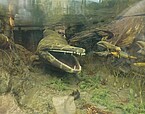Evolution of early land vertebrates: DFG sets up a new research group [14.05.24]
Natural History Museum Stuttgart and University of Hohenheim receive funding / Spokesperson is paleontologist Prof. Dr. Rainer Schoch
A key developmental step in the evolution of land vertebrates was the transition from water to land. The German Research Foundation (DFG) is setting up a new research group at the University of Hohenheim and the Natural History Museum Stuttgart (SMNS) to describe the histories of the animals and reconstruct the driving factors. The spokesperson of the new DFG research group "The Evolution of Life Histories in Early Terrestrial Vertebrates" is Prof. Dr. Rainer Schoch. He heads the Hohenheim Department of Palaeontology and the department of the same name at the Natural History Museum Stuttgart. The two institutions have been working together successfully for many years.
In contrast to birds and reptiles, which lay eggs, mammals such as humans give birth to their offspring alive. Some animals care intensively for their young while others rely on some of their many offspring surviving. And all vertebrates have common ancestors.
"We know that the first animals moved from water to land around 360 million years ago," said Prof. Dr. Rainer Schoch. "But how these animals shaped their lives is still largely unknown. Did they lay their eggs in the water or on land? How long did they live, when did they become sexually mature, and what was their metabolism like? To answer such questions, we take a new perspective in our research groups: We study the entire life cycle, from when they hatched from the egg through the larval period and metamorphosis to the adult animal."
Bone sections provide new insights
The researchers are focusing primarily on analyzing fine structures in the fossil bones. "This reveals a lot about the animals’ survival strategies. We are investigating the relationship between body size, development rate, sexual maturity, number of offspring, and lifespan of a species, all of which are controlled by natural selection," stated Prof. Dr. Schoch.
This sheds light on the evolutionary strategies that have produced the diversity of today’s life cycles in frogs, lizards, birds, and mammals, for example. According to Prof. Dr. Schoch, the research group is introducing a completely new aspect to the history of evolution. "In addition, the findings could also contribute to a better understanding of current problems – for example, the question of which strategies different species use to react to climate change."
Funding from the German Research Foundation (DFG)
In addition to the University of Hohenheim and the Natural History Museum Stuttgart, the universities of Bonn and Mainz and the Museum für Naturkunde Berlin are also involved in the DFG research group. The DFG's funding for the research group amounts to around four million euros.
The DFG is setting up a total of ten new research groups, one clinical research group, and two research training groups. Together they will receive around 56 million euros for the first funding period. This was announced by the DFG on 25 March 2024. DFG research groups enable scientists to address current and pressing issues in their fields and establish innovative research directions. They are funded for up to eight years. In total, the DFG currently funds 192 research groups, 13 clinical research groups, and 15 centers for advanced studies in humanities and social sciences.
Additional information
- Paleontological research at the SMNS: https://www.naturkundemuseum-bw.de/en/research/paleontology
BACKGROUND: Natural History Museum Stuttgart
Focus on innovative research and knowledge transfer
With its research collections, the “archives of diversity,” the museum houses over 12 million objects. Its scientific activities focus on researching the evolution of life and analyzing the biodiversity of different ecosystems. In two permanent exhibitions, changing special exhibitions, events and guided tours, the Natural History Museum Stuttgart conveys both basic natural history knowledge and current research findings to the general public. This promotes a lasting understanding of nature and its complex interrelationships.
www.naturkundemuseum-bw.de/en/
BACKGROUND: University of Hohenheim
Founded in 1818 in response to devastating famines, the University of Hohenheim is the oldest university in Stuttgart. Even 200 years later, the highly specialized university continues to pursue its founding mission of making innovative contributions to solving global challenges through research and teaching. Hohenheim is Germany’s leading university in agricultural research and food sciences, as well as strong and unparalleled in natural, social, and communication sciences. The University of Hohenheim teaches and conducts research on topics such as bioeconomy, sustainability, climate protection, species conservation, food security, and alternative sources of energy and raw materials.
www.uni-hohenheim.de/en
Text: Elsner
Contact for press:
Prof. Dr. Rainer Schoch, Natural History Museum Stuttgart / University of Hohenheim (Department of Palaeontology)
T +49 711 8936143, E rainer.schoch@smns-bw.de
Natural History Museum Stuttgart Press Office: Meike Rech
T +49 711 8936107, E meike.rech@smns-bw.de






